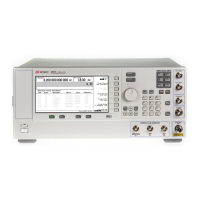E8257D/67D, E8663D PSG Signal Generators Service Guide
Troubleshooting
RF Path Description (Frequency Generation, Level Control, and Modulation)
1-101
A23 Lowband Coupler/Detector, A24 Highband Coupler, and A25 High Band Detector
The coupler couples off a portion of the RF signal which is then detected and used to monitor the RF output power
level. The detector converts the coupled RF signal to a dc voltage that is routed to the A10 ALC, where it is compared
to a reference voltage and integrated. The integrated output provides the ALC diode bias.
The A23 Lowband Coupler/Detector is used for frequencies ≤2 GHz; the A24 Highband Coupler and A25 Highband
Detector are used for frequencies >2 GHz.
In 20 GHz analog and vector instruments, the A24 Highband Coupler and A25 Highband Detector are located after the
A30 Modulation Filter. In 40 GHz analog models, the A24 Highband Coupler and A25 Highband Detector are located
after the A27 40 GHz Doubler. In models with output frequencies above 40 GHz, the A24 Highband Coupler and
A25 Highband Detector are located after the A36 Quadraplier. In vector models with output frequencies above 20 GHz,
the A24 Highband Coupler and A25 Highband Detector are located after the A37 Upconverter. The output of the
A24 Coupler is routed to either the attenuator (the attenuator is optional for the analog models and standard for the
vector models) or the RF output connector.
The A23 Lowband Coupler/Detector is located at the end of the lowband path, prior to the A30 Modulation Filter,
where the low band signal is switched into the high band path. Because the A23 Lowband Coupler/Detector is a single
unit, the coupler and detector must be replaced together; the A24 Highband Coupler and A25 Highband Detector are
separate units that you can replace independently.
A27 40 GHz Doubler (Analog 40 GHz Models and Vector 44 GHz Models)
The 40 GHz Doubler generates frequencies from 20 to 40 GHz. The doubler has two inputs from the A30 Modulation
Filter. One input routes frequencies ≤20 GHz to a bypass switch, and the other input routes 10 to 20 GHz signals to
the 40 GHz Doubler. After doubling, band pass filters eliminate unwanted harmonics. In analog models, the
40 GHz output is routed to the A24 Highband Coupler and A25 High Band Detector. In vector models, the
A27 40 GHz Doubler output is routed to the LO input of the A37 Upconverter.
A29 20 GHz Doubler
The A29 20 GHz Doubler provides RF signals to the:
• synthesis loop (described on page 1- 93)
• low (< 3.2 GHz) band RF path (to the A6 Frac–N)
• high (> 3.2 GHz) band RF path
Frequencies 3.2 to 10 GHz pass through the A29 20 GHz Doubler. Frequencies 10 to 20 GHz are generated in the
doubler by doubling the 5–10 GHz YO signal. Frequencies > 3.2 GHz are routed from the A29 20 GHz Doubler to the
A30 Modulation Filter (in analog models) or to the 3 to 20 GHz I/Q Modulator (in vector models).
A30 Modulation Filter
One function of the A30 Modulation Filter is to switch the highband and lowband signals into a common path.
Therefore the output frequency range of the A30 Modulation Filter is 100 kHz to 20 GHz. For frequencies > 3.2 GHz,
the A30 Modulation Filter provides amplitude and pulse modulation circuitry, power level control, and filtering.
Frequencies < 3.2 GHz are simply switched through the A30 Modulation Filter and are not filtered or modulated by
any circuitry in the A30 Modulation Filter.
The highband ALC diode within the A30 Modulation Filter provides level control and amplitude modulation. With no
bias applied to the ALC diode, output power is at the maximum power level. In pulse operation, the pulse diode must
be biased on for the RF signal to pass through the pulse modulation circuitry.
In 20 GHz analog signal generators, the A30 Modulation Filter output is routed to the A24 Highband Coupler and
A25 Highband Detector. In 40 GHz analog instruments, two outputs from the A30 Modulation Filter are routed to the
A27 40 GHz Doubler, one input for frequencies ≤20 GHz to a bypass switch and one to the 40 GHz Doubler circuit. In
signal generators with output frequencies above 40 GHz, the A27 40 GHz doubler is replaced with the
A36 Quadraplier. In these instruments two A30 Modulator outputs go to the A36 Quadraplier. One of the
A30 Modulator outputs is connected to the A36 Quadraplier bypass circuit and the other to the doubler circuit.

